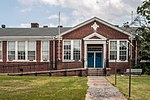St. Paul VI Catholic High School (known as PVI or Paul VI) is a Roman Catholic college preparatory school in Chantilly, Virginia, United States.The school was previously located in southwest Fairfax, Virginia and is named after Pope Paul VI. In 2020 it relocated to Loudoun County, specifically Chantilly, Virginia.
It competes in the Washington Catholic Athletic Conference and Virginia Independent State Athletic Association (VISAA) and has a high-profile athletic rivalry with Bishop O'Connell High School in Arlington.
Paul VI opened for the 1983–84 school year, accepting freshmen and sophomore students only. The next year (1984–85), the school was open to freshmen through juniors, and 1985–86 saw the first senior class. The Diocese of Arlington purchased the school building, which was in a dilapidated condition, from George Mason University, which had owned it for about a decade. The structure had originally been Fairfax High School, which opened in 1935 and relocated to a new facility in January 1972. One wing of the building housed Alzheimer patients until the school's third year.
During its first years, the school was ministered by five Oblates of St. Francis de Sales, who also taught classes and one of whom (Rev. Donald Heet, OSFS) served as the principal. The remainder of the faculty were lay teachers. The other ordained faculty were Rev. Robert Mulligan, OSFS and Rev. John Lyle, OSFS. In 2000, the school selected its first principal who was not from the Oblate order. Mr. Philip Robey was selected for this position, and stepped down seven years later. He was replaced by Mrs. Virginia Colwell, a former English teacher at Paul VI.
In 2020, the high school relocated to the South Riding area in Loudoun County, amid the COVID-19 pandemic. The move had been planned prior to the pandemic.
The team name "Panthers" was voted by the student body during the school's first year. The original school colors were brown and gold until the 1999–2000 school year. The school moved away from brown in favor of black, which was considered more stylish by the student body.
After the canonization of Pope Paul VI in October 2018, the school was renamed St. Paul VI Catholic High School to further honor its patron and namesake.



